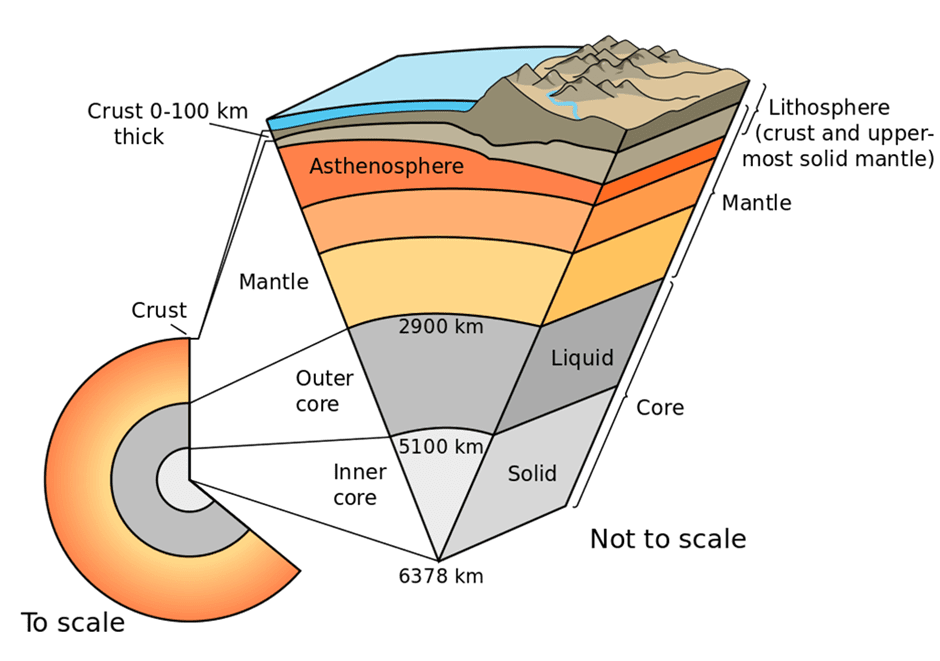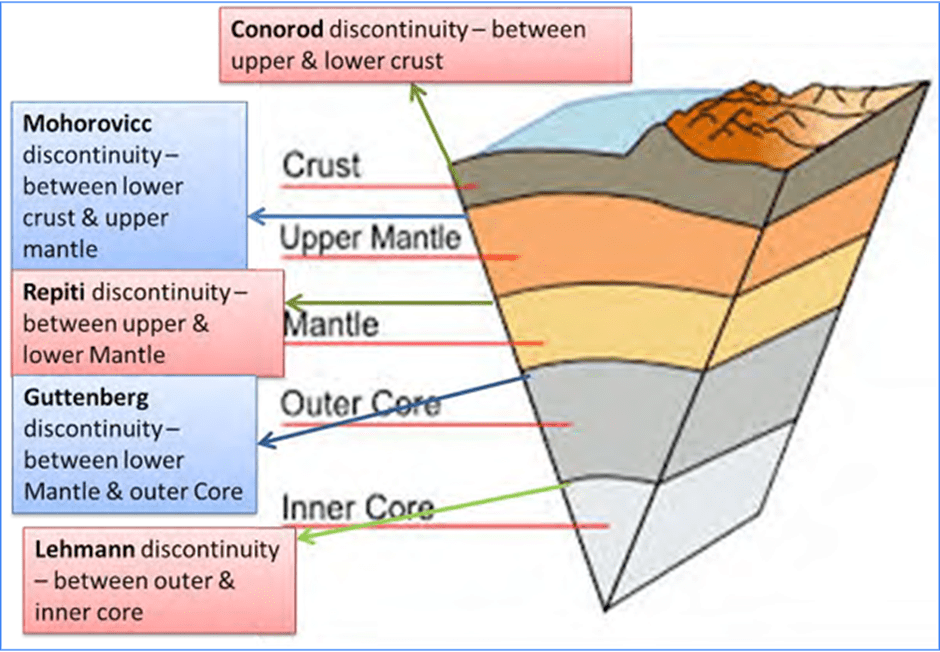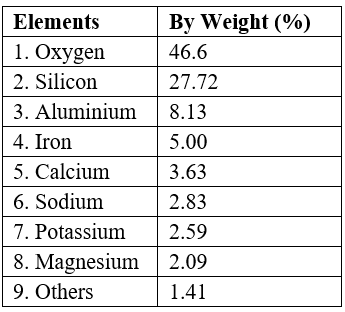Physical Condition of Interior of Earth | Geography Optional for UPSC PDF Download
Introduction - Interior of Earth
In this Geomorphology article, we will delve deeper into understanding the Earth's interior. One might wonder why studying the Earth's interior is important and what benefits can be derived from understanding its basic structure. Here are some reasons:
- Understanding the Earth's interior helps us comprehend the changes that occur on and beneath the Earth's surface.
- It allows us to better understand geophysical phenomena such as volcanism and earthquakes.
- We can gain insights into the internal structure of various objects within the solar system.
- It enables us to understand the evolution and present composition of the Earth's atmosphere.
- It is crucial for future deep-sea mineral exploration and other resource management initiatives.
Now that we understand the importance of studying the Earth's interior, let's discuss the sources that provide knowledge about it and explore the composition of the Earth's interior.
Sources to study the earth’s interior
The methods for acquiring knowledge about the Earth's interior can be grouped into two categories:- Direct sources
- Mining and drilling: These activities enable us to directly access and observe the Earth's interior, allowing us to collect samples and gather information about its composition and structure.
- Volcanic eruptions: Eruptions bring materials from deep within the Earth to the surface, providing us with valuable information about the composition and behavior of the Earth's interior.
- Indirect sources:
- Temperature and pressure variations: By studying how temperature and pressure change with depth, we can infer information about the Earth's interior, such as its composition, density, and layering.
- Meteors: Analyses of meteorites can provide information about the composition of the Earth's interior, as they are believed to have originated from the same materials that formed the Earth.
- Seismicity: Seismic waves generated by earthquakes travel through the Earth and are affected by the materials they encounter. By analyzing these waves, we can gain insights into the Earth's interior structure, such as the location of various layers and their properties.
Structure of the earth’s interior
The structure of the earth’s interior is made up of several concentric layers. Structure of Interior of The Earth is divided into three layers-
- Crust
- Mantle
- Core
 Interior of The Earth
Interior of The Earth
Crust
- The Earth's crust is its outermost solid layer, typically measuring between 30-50 km in thickness. This layer varies in thickness depending on whether it is beneath oceanic or continental regions. The oceanic crust is generally thinner, ranging from 5-30 km, while the continental crust is thicker, measuring between 50-70 km. In areas with major mountain systems, such as the Himalayan region, the continental crust can be as thick as 70-100 km.
- The crust makes up only 0.5-1.0% of the Earth's total volume. Its outer covering is composed of sedimentary material, primarily granitic rocks. Below this layer, there are crystalline, igneous, and metamorphic rocks, which are generally acidic in nature. The lower portion of the crust consists of basaltic and ultra-basic rocks.
- In terms of density, the outer crust has an average density of 2.8, while the lower crust has a density of around 3.0. The continental crust is primarily composed of lighter silicates made of silica and aluminum, also known as "sial." In contrast, the oceanic crust contains heavier silicates made of silica and magnesium, referred to as "sima."
- The boundary between the Earth's lower crust and the upper mantle is known as the Mohorovicic (Moho) discontinuity.
 Discontinuities
Discontinuities
Mantle
- The mantle refers to the layer of the Earth's interior that lies beyond the crust. It stretches from a depth of about 35 kilometers, known as Moho's discontinuity, down to approximately 2,900 kilometers. The upper section of the mantle, called the asthenosphere, is situated just below the crust. Together, the crust and the uppermost part of the mantle make up the lithosphere, which has a thickness varying between 10 and 200 kilometers.
- Below the asthenosphere lies the lower mantle, which is in a solid state. The mantle is denser than the crust, with a density ranging from 3.3 to 5.5. It comprises 83 percent of the Earth's total volume and accounts for 68 percent of its total mass. The mantle is primarily composed of silicate minerals that are rich in iron and magnesium.
Asthenosphere
- The upper portion of the mantle is called the asthenosphere.
- It is considered to be extending up to 400 km.
- It is the main source of magma that finds its way to the surface during volcanic eruptions. It has a density higher than the crust.
Core
- The core-mantle boundary is located at the depth of 2900 km.
- Core lies between 2900 km and 6400 km below the earth’s surface.
- The outer core is liquid while the inner core is solid.
- The density of the core is higher than the mantle and varies from 5.5 to 13.6 g/cm3
- The core is made up of heavy material mostly constituted by nickel and iron [nife].
- Volume and mass of core are 16% and 32% of the total volume and mass of the earth respectively.
Earth’s Layers- Seismic Discontinuities
- Conorod Discontinuity– between upper and lower crust
- Mohorovicic Discontinuity (Moho) – separates the crust from the mantle, its average depth being about 35 km.
- Repiti Discontinuity – between the upper and lower mantle
- Gutenberg Discontinuity – lies between the mantle and the outer core. Below 2900 km from earth’s surface.
- Lehman Discontinuity- between inner and outer core.
The Major Elements of the Earth’s Crust:

Conclusion
Understanding the Earth's interior is crucial for various reasons, including predicting geophysical phenomena, studying the evolution of the atmosphere, and managing resources. The Earth's interior is composed of several concentric layers, including the crust, mantle, and core, each with distinct properties and compositions. Knowledge about the Earth's interior is derived from both direct and indirect sources, such as mining, volcanic eruptions, temperature and pressure variations, meteors, and seismicity. Studying these layers and their properties helps us gain valuable insights into the Earth's structure and behavior, contributing to our overall knowledge of the planet and the universe.Frequently Asked Questions (FAQs) of Physical Condition of Interior of Earth
Why is studying the Earth's interior important?
Studying the Earth's interior is essential for understanding changes that occur on and beneath the Earth's surface, comprehending geophysical phenomena such as volcanism and earthquakes, gaining insights into the internal structure of objects within the solar system, understanding the evolution and composition of the Earth's atmosphere, and supporting future deep-sea mineral exploration and resource management initiatives.
What are the direct sources for studying the Earth's interior?
Direct sources for studying the Earth's interior include mining and drilling activities, which allow us to directly access and observe the Earth's interior, and volcanic eruptions, which bring materials from deep within the Earth to the surface.
What are the indirect sources for studying the Earth's interior?
Indirect sources for studying the Earth's interior include studying temperature and pressure variations with depth, analyzing meteorites, and examining seismic waves generated by earthquakes.
What are the three main layers of the Earth's interior?
The three main layers of the Earth's interior are the crust, the mantle, and the core.
What are the major seismic discontinuities in the Earth's interior?
The major seismic discontinuities in the Earth's interior include the Conorod Discontinuity (between upper and lower crust), the Mohorovicic Discontinuity (Moho, between the crust and mantle), the Repiti Discontinuity (between upper and lower mantle), the Gutenberg Discontinuity (between the mantle and outer core), and the Lehman Discontinuity (between the inner and outer core).
|
303 videos|635 docs|252 tests
|
FAQs on Physical Condition of Interior of Earth - Geography Optional for UPSC
| 1. What are the sources to study the earth's interior? |  |
| 2. What is the structure of the earth's interior? |  |
| 3. What are seismic discontinuities in the earth's layers? |  |
| 4. How do seismic waves help in studying the earth's interior? |  |
| 5. What are some frequently asked questions about the physical condition of the earth's interior? |  |

















